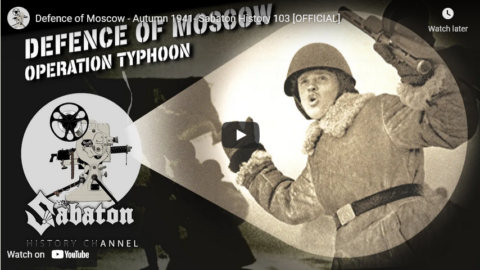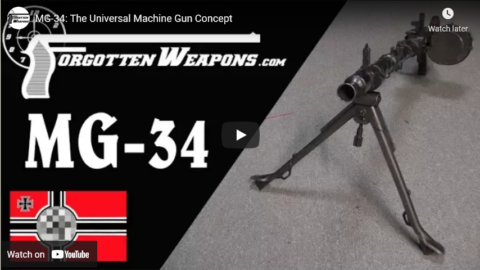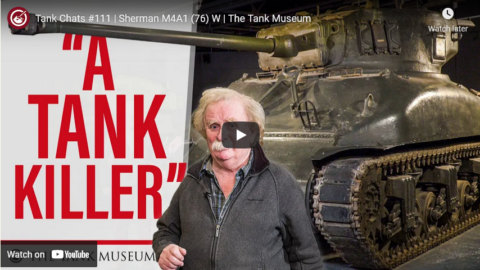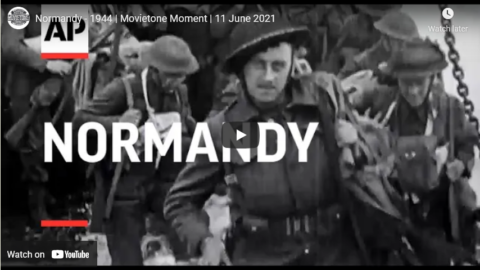Sabaton History
Published 17 Jun 2021While it is legendary, there is a lot of confusion and a lot of myths about Operation Typhoon, the German drive on Moscow in the fall of 1941, and Operation Barbarossa, the invasion of the Soviet Union that summer. Today I talk about the first 5.5 months of Barbarossa, and then Joakim and I discuss covers and covers of covers.
Support Sabaton History on Patreon: https://www.patreon.com/sabatonhistory
Listen to “Defence Of Moscow”: https://music.sabaton.net/DefenceOfMo…
Watch the Official Music Video of “Defence Of Moscow” here: https://www.youtube.com/watch?v=i7K4v…
Listen to Sabaton on Spotify: http://smarturl.it/SabatonSpotify
Official Sabaton Merchandise Shop: http://bit.ly/SabatonOfficialShopHosted by: Indy Neidell
Written by: Markus Linke and Indy Neidell
Directed by: Astrid Deinhard and Wieke Kapteijns
Produced by: Pär Sundström, Astrid Deinhard and Spartacus Olsson
Creative Producer: Maria Kyhle
Executive Producers: Pär Sundström, Joakim Brodén, Tomas Sunmo, Indy Neidell, Astrid Deinhard, and Spartacus Olsson
Community Manager: Maria Kyhle
Post-Production Director: Wieke Kapteijns
Editor: Karolina Dołęga
Sound Editor: Marek Kaminski
Maps by: Eastory – https://www.youtube.com/c/eastory
Archive: Reuters/Screenocean – https://www.screenocean.comColorizations by:
– Mikołaj Uchmann
– Julius Jääskeläinen – https://www.facebook.com/JJcolorization/Sources:
– National Archives Nara
– Narodowe Archiwum Cyfrowe NARA
– Bundesarchiv
– New York Public Library
– Train tracks icon by Danishicon from the Noun Project
– Picture of singer Loona courtesy of Sandstein https://commons.wikimedia.org/wiki/Ca…
– Imperial War Museums: HU 75543, PST 4712
– Australian War MemorialAll music by: Sabaton
RADIO TAPOK – Битва за Москву (В стиле Sabaton / ИзиРок / – Defence Of Moscow)An OnLion Entertainment GmbH and Raging Beaver Publishing AB co-Production.
© Raging Beaver Publishing AB, 2021 – all rights reserved.
June 19, 2021
June 18, 2021
Heydrich, Architect of the Holocaust, Dies – WAH 036 – June 1942, Pt. 1
World War Two
Published 17 Jun 2021Reinhard Heydrich is fighting for his life, as the hunt of his assassins continues. Meanwhile, news of the Nazi atrocities starts to reach the Allied countries.
(more…)
June 17, 2021
MG-34: The Universal Machine Gun Concept
Forgotten Weapons
Published 7 Oct 2017The MG34 was the first German implementation of the universal machine gun concept — and really the first such fielded by any army. The idea was to have a single weapon which could be used as a light machine gun, heavy machine gun, vehicle gun, fortification gun, and antiaircraft gun. The MG34 was designed to be light enough for use as an LMG, to have a high enough rate of fire to serve as an antiaircraft gun, to be compact and flexible enough for use in vehicles and fortifications, and to be mounted on a complex and advanced tripod for use as a heavy machine gun.
Mechanically, the MG34 is a recoil operated gun using a rotating bolt for locking. It is chambered for 8mm Mauser, and feeds from 50-round belt segments with a clever and unique quick-change barrel mechanism. The early versions were fitted with adjustable rate reducers in the grips allowing firing from 400 to 900 rounds per minute, and also had an option for a top cover which would fit a 75-round double drum magazine. Both of these features were rather quickly discarded, however, in the interest of more efficient production. However, the gun fulfilled its universal role remarkably well.
The MG34 was considered a state secret when first developed, and despite entering production in 1936 it would not be formally adopted until 1939 — by which time 50,000 or so had already been manufactured. It would comprise about 47% of the machine guns in German service when the Wehrmacht invaded Poland, but would be fully standardized by March of 1941. It was replaced by the MG42 later in the war, as that weapon was both faster and cheaper to produce and also required substantially less of the high-grade steel alloys that Germany had limited supplies of. However, it would continue to be produced through the war, particularly for vehicle mounts.
http://www.patreon.com/ForgottenWeapons
Cool Forgotten Weapons merch! http://shop.bbtv.com/collections/forg…
If you enjoy Forgotten Weapons, check out its sister channel, InRangeTV! http://www.youtube.com/InRangeTVShow
June 16, 2021
By Sea, By Land – A Global History of the Marines – WW2 Special
World War Two
Published 15 Jun 2021Naval infantrymen have long been a feature of warfare. In the build-up to 1939, they took on new functions and tactics. The Royal Marines, the US Marine Corps, Black Death, Kaiheidan, and more are ready for all-out amphibious warfare in the Pacific Theatre and beyond.
(more…)
Tank Chats #111 | Sherman M4A1 (76) W | The Tank Museum
The Tank Museum
Published 20 Nov 2020Join The Tank Museum’s Historian David Fletcher as he discusses the Sherman M4A1 (76) W, a late war variant of the Sherman M4A1 which was introduced into service in the summer of 1944. The M4A1 (76) W still had a cast hull, but improved frontal armour, a more powerful version of the Continental radial engine and was up-gunned from the original M4A1, with a 76mm gun.
Support the work of The Tank Museum on Patreon: ► https://www.patreon.com/tankmuseum
Visit The Tank Museum SHOP & become a Friend: ► tankmuseumshop.orgTwitter: ► https://twitter.com/TankMuseum
Instagram: ► https://www.instagram.com/tankmuseum/
#tankmuseum #tanks
June 14, 2021
QotD: Obsolescent carrier aircraft in the Pacific war
The most obsolete first-line strike aircraft in any carrier force in 1942 was the American Douglas TBD Devastator torpedo bomber (206mph, 2 x.303 mg. 1,000lbs of a torpedo or bombs, range 716 miles). Despite — or because of — being the first monoplane on any carrier air-wing (1937!), it had never been a very good aircraft. Fully loaded with a torpedo (a much lighter torpedo than used by anyone else), it had a hard time getting off the deck, and had a much reduced speed and range. In fact its attack speed was actually slower than a [British Fairey] Swordfish, and it lacked the Swordfish’s maneouvrability or capacity to take damage. Used in daylight (the only way it could be used), it was an absolute death-trap if there was any airborne opposition at all. In fact the role played by the Devastators at the Battle of Midway was as [unintentional] kamikaze decoy targets to draw the Japanese fighter forces out of place. A point made even clearer by the fact that the few Devastators which had managed to attack at Coral Sea had usually seen their torpedoes fail to work anyway. (The American carrier fleet would not get a successful airborne torpedo until mid 1943!)
The next most obsolete was the Japanese Aichi D3A “Val” dive-bomber (266mph, 3 x 7.7 mg, 1 x 500lb and 2 x 60lb bombs, 970 mile range) which had also entered service in the mid 30’s. It was a fixed landing gear dive-bomber modeled on the famous Junkers Ju87 (183mph, 1 x 7.7mm mg, 1,000lb bomb load, 621 mile range), and was just as good a dive bomber … if there was no opposition. Unlike the Ju87 (and like the [British Blackburn] Skua) the Val also had the ability to defend itself as a second-rate fighter once the bombs had been dropped. Still, the Val relied for success on clear skies, and achieved excellent results under those conditions at Ceylon (cruisers Devonshire and Cornwall and unarmed old carrier Hermes) and Coral Sea (carrier Lexington). Under even moderate air pressure at Trincomalee and Midway the performance fell off markedly, and later in the war the phrase that comes to mind is “Great Marianas Turkey Shoot”. Nonetheless they had to soldier on because the replacement aircraft was too fast for the smaller carriers that were to become the majority of the Japanese carrier fleet after Midway.
Nigel Davies, “Comparing naval aircraft of World War II”, rethinking history, 2010-12-20.
June 13, 2021
Sevastopol Must Fall! – WW2 – 146 – June 13, 1942
World War Two
Published 12 Jun 2021It’s a week of starts and stops. The Battle of Sevastopol kicks into high gear, and the Battle of Gazala enters its third phase. And what is going on in the Pacific just one week after Midway?
(more…)
Wartime Changes: The Bren MkI Modified and Bren MkII
Forgotten Weapons
Published 3 Mar 2021http://www.patreon.com/ForgottenWeapons
https://www.floatplane.com/channel/Fo…
Cool Forgotten Weapons merch! http://shop.bbtv.com/collections/forg…
The British lost some 90% of their stock of Bren light machine guns in the disastrous Dunkirk evacuation, and in the following months rushed to rearm. Part of this program was a two-tiered simplification of the Bren design. First was a MkI Modified Bren (which was not marked any differently than the original MkI), and this was followed by a MkII design. These patterns simplified many of the machining operation required to produce the Bren, significantly reducing the number of required machining operations. The most visually distinctive elements of the MkII pattern were the omission of the stainless steel flash hider assembly and the replacement of the original dial rear sight with a simple ladder sight. In addition, changes were made to the buttstock, buttplate, receiver profile, gas block, and bipod. Both Enfield and Inglis would produce the simpler MkII Brens by the middle of the war. Despite the many changes made, the core operating components (bolt, bolt carrier, etc) were left unchanged, so they could still interchange between all patterns of the gun in service.
Contact:
Forgotten Weapons
6281 N. Oracle #36270
Tucson, AZ 85740
June 12, 2021
Normandy – 1944 | Movietone Moment | 11 June 2021
British Movietone
Published 11 Jun 2021On this day in 1944, five days after the D-Day landing, the allied forces converged in Normandy. Here is a British Movietone report covering the event.
More and more reinforcements and supplies arrive in Normandy each day. In the skies Allied air power continues to bomb and strafe the enemy. Captured German film shows Rommel and von Rundstedt visiting the vast concrete fortifications on the coast which were thought to be impassable. Mr Churchill arrived onboard HMS Kelvin and was greeted by General Montgomery as he came ashore.
Cut story – Dusk or dawn shot of destroyer with sun rising or sinking in background. Sunrise with armada in fore. Yanks board LCIs. Shots of LCTs. Beached equipment unloaded. GV of activity on beach. British troops of LTC. CU Tedder on bridge of ship. GS of Ramsay & Vian. Tedder, Ramsay & Vian walk along raft into camera. Elevated shot of activity on beach, very good. Troops build airstrip, bulldozers etc. at work. Plane takes off. Camera gun – shooting up trains, transport, & other targets, several large explosions. British pass through street, Frenchmen look on. AFU – British soldiers at look-out with field glasses. Troops (Canadian or British) run through fields & wooded country. Troops through street, French clap. Army transport passes through street, directed by soldier. Yanks march through streets. POW along roads, & over beach, wade out to LCT, one attempts to pull up sock while walking. Captured German reel GS of Rommel & Rundstedt. CU Rommel. SCU of coastal guns, & various shots of fortifications, pillboxes etc. Rommel & Rundstedt walk round inspecting same, look at double barrel coastal gun. SCU of barrel of guns, & various shots of Atlantic Wall (AFU British troops knock part of “Wall” down which they have captured). Eisenhower, Marshall & Arnold on bridge of ship. GV of destroyer Kelvin at sea – very good. CU Churchill in Trinity House uniform, wearing glasses. Churchill assists Brooke with “Mae West” life jackets. Both seated on deck Kelvin at sea. CU Churchill. Kelvin passes Nelson, Ramillies & other warships also large part of armada. Churchill transfers … ships, sailors cheer as he leaves. CU Churchill. CU Smuts both very good. Churchill, Smuts & Brooke in “Duck” [DUKW]. Churchill leans over side talks to Montgomery, Churchill alights from “Duck”. Shakes hands with Monty. The above four in group on beach, walk through crowds of soldiers. AFU – Monty stands on raised platform addresses troops (silent) Monty & Churchill through crowds. Churchill with Monty & climbs into Jeep. SEE STORY NUMBER 44914/2 & 44914/3 FOR CUTS
AP Has HD copy – HD ProRes 422 4:3 – 24fpsDisclaimer: British Movietone is an historical collection. Any views and expressions within either the video or metadata of the collection are reproduced for historical accuracy and do not represent the opinions or editorial policies of the Associated Press.
You can license this footage for commercial use through AP Archive – the story number bm44914
#Normandy #WWII #DDay
Find out more about AP Archive: http://www.aparchive.com/HowWeWork
Twitter: https://twitter.com/AP_Archive
Tumblr: https://aparchives.tumblr.com/
Instagram: https://www.instagram.com/APNews/
June 11, 2021
Is Finland an Ally of Nazi Germany? – Carl Gustaf Mannerheim – WW2 Biography Special
World War Two
Published 10 Jun 2021Carl Gustaf Mannerheim is a national hero after his service in everything from the Finnish Civil War to the Winter War. But did he plan a war of aggression with Nazi Germany against the Soviet Union? And if so, did Hitler and Stalin even give him any choice in the matter?
(more…)
June 10, 2021
QotD: “Defending” democracy using totalitarian methods
One of the peculiar phenomena of our time is the renegade Liberal. Over and above the familiar Marxist claim that “bourgeois liberty” is an illusion, there is now a widespread tendency to argue that one can only defend democracy by totalitarian methods. If one loves democracy, the argument runs, one must crush its enemies by no matter what means. And who are its enemies? It always appears that they are not only those who attack it openly and consciously, but those who “objectively” endanger it by spreading mistaken doctrines. In other words, defending democracy involves destroying all independence of thought. This argument was used, for instance, to justify the Russian purges. The most ardent Russophile hardly believed that all of the victims were guilty of all the things they were accused of: but by holding heretical opinions they “objectively” harmed the régime, and therefore it was quite right not only to massacre them but to discredit them by false accusations. The same argument was used to justify the quite conscious lying that went on in the leftwing press about the Trotskyists and other Republican minorities in the Spanish civil war. And it was used again as a reason for yelping against habeas corpus when Mosley was released in 1943.
These people don’t see that if you encourage totalitarian methods, the time may come when they will be used against you instead of for you. Make a habit of imprisoning Fascists without trial, and perhaps the process won’t stop at Fascists. Soon after the suppressed Daily Worker had been reinstated, I was lecturing to a workingmen’s college in South London. The audience were working-class and lower-middle class intellectuals — the same sort of audience that one used to meet at Left Book Club branches. The lecture had touched on the freedom of the press, and at the end, to my astonishment, several questioners stood up and asked me: Did I not think that the lifting of the ban on the Daily Worker was a great mistake? When asked why, they said that it was a paper of doubtful loyalty and ought not to be tolerated in war time. I found myself defending the Daily Worker, which has gone out of its way to libel me more than once. But where had these people learned this essentially totalitarian outlook? Pretty certainly they had learned it from the Communists themselves! Tolerance and decency are deeply rooted in England, but they are not indestructible, and they have to be kept alive partly by conscious effort. The result of preaching totalitarian doctrines is to weaken the instinct by means of which free peoples know what is or is not dangerous. The case of Mosley illustrates this. In 1940 it was perfectly right to intern Mosley, whether or not he had committed any technical crime. We were fighting for our lives and could not allow a possible quisling to go free. To keep him shut up, without trial, in 1943 was an outrage. The general failure to see this was a bad symptom, though it is true that the agitation against Mosley’s release was partly factitious and partly a rationalisation of other discontents. But how much of the present slide towards Fascist ways of thought is traceable to the “anti-Fascism” of the past ten years and the unscrupulousness it has entailed?
George Orwell, Unpublished Preface to Animal Farm, 1945.
June 9, 2021
Do the Nazis Have Atomic Bombs? – WW2 – Spies & Ties 03 – Sam & Erwin part 2
World War Two
Published 8 Jun 2021All belligerents are working hard to develop a powerful nuclear super-weapon. The Americans wonder how far along the Germans are, and send in their spies.
(more…)
Very Rare and Mostly Pointless: the Bren Fixed Line Sight
Forgotten Weapons
Published 25 Feb 2021http://www.patreon.com/ForgottenWeapons
https://www.floatplane.com/channel/Fo…
Cool Forgotten Weapons merch! http://shop.bbtv.com/collections/forg…
The very early production MkI Bren light machine guns were made with two dovetail brackets on the left side of the receiver. The rear one was for the standard rear sight, and the front one was to accommodate two types of optical sights. A mounting for the No.32 telescopic sight (the same one used on the No4(T) sniper rifle) was planned, but never produced. What was made in small numbers by the Plessey company was a “fixed line sight”. This was really more like a surveyor’s tool than a traditional sight, and it used the same optical element as the Vickers dial sight that was introduced alongside it in 1939. The purpose was to allow a tripod-mounted Bren to be set up with specific limits to its field of fire, and then for the gun to be removed, used on the bipod elsewhere, and returned to the tripod and confirm the field of fire, especially in the dark. This is a somewhat technically complex task, but not one that was actually needed very much for the Bren. As a result, production and use of the fixed line sights was very limited, and the sights are extremely rare today. The mounting bracket on the Bren receiver was rather quickly dropped from production as an unnecessary waste of machining time.
Contact:
Forgotten Weapons
6281 N. Oracle #36270
Tucson, AZ 85740
June 8, 2021
Midway pt.2 – A New War? – WW2 – 145c – June 7, 1942
World War Two
Published 7 Jun 2021We left off last time with several burning behemoths. Watch today to see the action that follows, not just on the high seas, but also in Alaska. We also turn to Washington DC and Tokyo and follow the reaction to the Battle of Midway there. The Japanese one may surprise you.
(more…)
June 7, 2021
Germany to Strike Strongest Fortress in the World – WW2 – 145b – June 6, 1942
World War Two
Published 6 Jun 2021Midway isn’t the only fight right now. Germany is trying to crack the mighty fortress of Sevastopol and take the whole Crimea. In North Africa, Rommel is routing the Allies, but in Malta the arrival of ever more fighter planes bodes well for the Allies.
(more…)









